Killiney is not short of impressive seven-figure sum homes. But if you ever wanted to elevate your position over well-heeled neighbours all you need do is climb the 72 steps to the top of the viewing tower of Ashurst.
The original turret of the high Victorian gothic residence was extended heavenwards by its most famous owner, former archbishop of Dublin John Charles McQuaid, about 100 years after it was first constructed.
The bishop, a close friend of Éamon de Valera, took up residence in 1945. A keen astronomer, he added the belfry tower, which today extends about 27m and offers the most bewitching views of Killiney Bay. From this lofty position you can see north to Sorrento Terrace, west to the obelisk at the top of Killiney Hill, and south to Bray Head and the Sugarloaf.
It is said that he liked to ascend it to be closer to God, but the authoritarian figure probably also got a kick of commanding one of the highest spots in the capital. He is reported to have been fond of shooting too, and would aim his .22 rifle at approaching magpies.
But the tower is now a mere talking point in a house that discreetly delivers a level of creature comfort that if in situ in his time may have given the cleric a serious case of Catholic guilt.
Designed by architectural practice Lanyon, Lynn and Lanyon, Ashurst was originally built for Sir Compton Domville, a member of parliament and landlord. It is probable that a partner in the firm, architect Charles Lanyon, designed it. He is responsible for the Palm House in the Botanic Gardens, and Queen’s University, Belfast, to which Ashurst bears a resemblance.
The current owners bought it in 2013 for €4.065 million, according to the Property Price Register, well above its then asking price of €3.5million.
They spent the next 2½ years converting the former archbishop’s residence, a space architect Paul Brazil of Brazil Associates Architects described as “austere”, into a very fine, very discreetly done, high-end home. They also employed conservation architect John Redmill to advise, and estimate they spend more than the purchase price on upgrading it.
The tower had to be stabilised and the property’s 148 sash windows, many of which have had their window boxes and shutters restored or replaced.
The floors were all lifted and insulated, and geothermal underfloor heating was laid throughout the ground floor. Many needed replacing so the owners selected smoked oak boards by Oscar Ono. This is a brand that smokes each board by hand and was selected to floor fashion superbrand Christian Dior for its offices in France.
The huge oak front doors open into a panelled porch where the Victorian tiled floor has been refreshed. The entrance hall, a room with beautiful timber panelling, where the walls are topped with the crests of the four provinces of Ireland and with fine simple plasterwork overhead gently restored by the Old Mould Company, is now a music room. Home to a baby grand piano and harp, it has a timber arts and crafts carved surround decorating its open fire.
The stained oak panelling throughout, having faded to a strong orange, has been toned down. Some has been painted while the main staircase is now coated in a soft lime that also softens its gothic carving.
The key shift was to move the living and kitchen into the main part of the house, says Brazil. What were once formal good rooms are now used everyday and connect rooms which extend through on the property’s sunny south side.

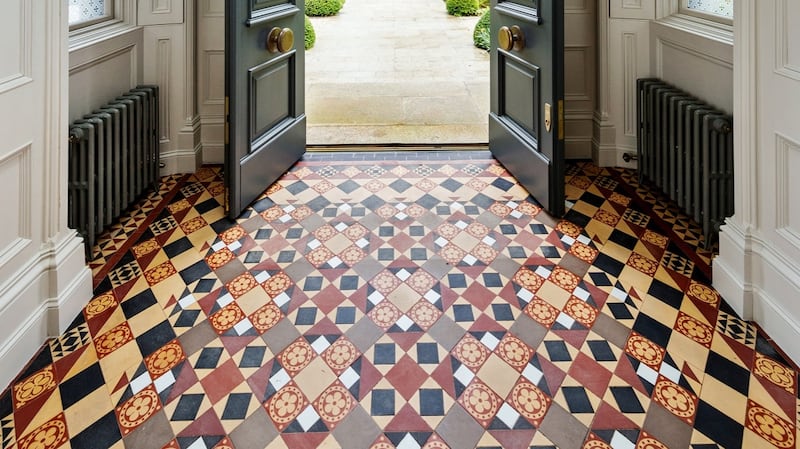

Now relaxed spaces, they are perfectly equipped for family life. The dual-aspect living room has a grey marble chimney piece, gothic arched windows and cream velour sofas that have practical removable covers as the owners have two dogs.
During the refurbishment double doors were suggested to connect the living room to the kitchen. The owners wanted an opening instead. When the builders took down the partition, they discovered a perfectly preserved gothic arch leading through.
The kitchen, a design by O’Connors of Drumleck, is imbued with a wealth of features including a custom pewter canopy over the Aga, antiqued glass splashback and a bay window that frames a view of the Sugarloaf. There is a large island that is perfectly in proportion to the room and its 3.5m high ceiling.
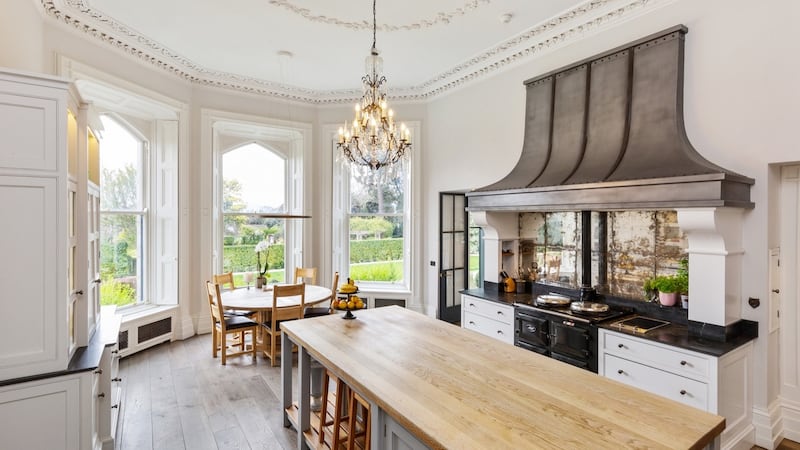
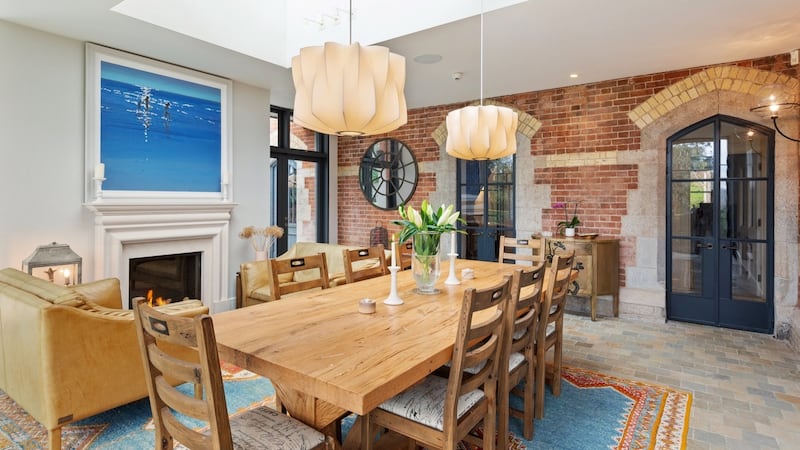
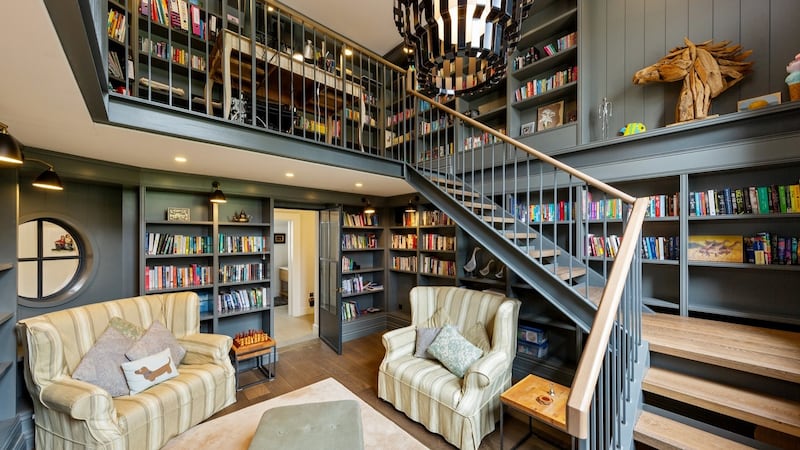
Steps down lead to a new addition to connect the house to the garden. Rather than opting for Victorian pastiche they chose a contemporary orangery made of steel Crittal-style windows and doors by Nigel Saunders. The owners describe it as “industrial gothic”.
This gorgeous room opens out to a paved terrace with a fragrant herb garden, outdoor fireplace and barbecue station. It also links, via a second staircase, to a wing of the property that used to accommodate the kitchen and the rooms of the nuns who served McQuaid.
These have been reduced in number to give the property a large triple garage, a comms room and a boot room. as well as an everyday entrance to the house.
There is a third front entrance at the end of this hall that gives you private access to the new mezzanine level where the owners have a stylish office of glass and weatherproof Cedral cladding with access to a south-facing terrace.
Also on the mezzanine level is a TV room, en suite bedroom and double-height library, a cosy space warmed by a wood-burning stove.
Back in the formal part of the house there are four fine-sized bedrooms on the first floor. The main has views of Killiney Bay and Bray Head, with a dressing room and large en suite. The view from the bishop’s preferred accommodation is a view of the Sugarloaf and the south Dublin and Wicklow mountains. The bathrooms throughout are as well appointed as in any five-star hotel. There are two more sizeable guest rooms in the wing.
The finish, executed by contractor Whelan O’Keefe, is first class. Developer Damien Tansey used the firm on his D4 period conversions – 19 Pembroke Road, and 78 and 80 Merrion Road. Husswood Joinery did all the carpentry. The workmanship throughout is flawless.

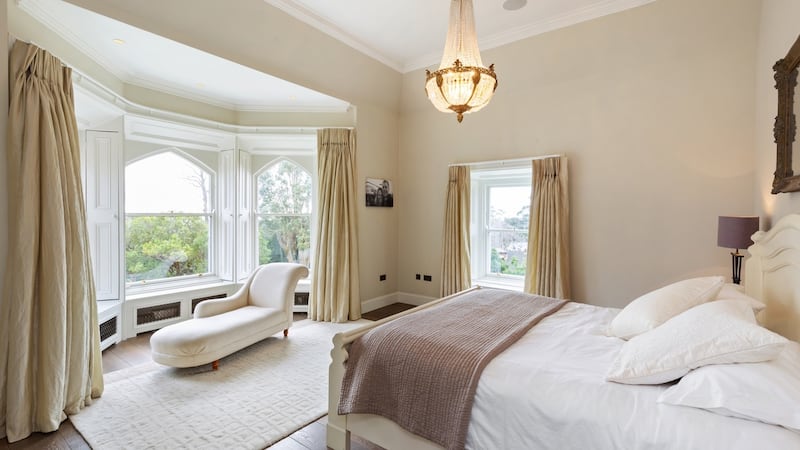
A bespoke solid oak staircase now leads to the top of the tower where custom lighting allows you to change the colour of its illumination. Sports fans might like to make it green on the days Ireland is playing while romantics might like the red option for Valentine’s Day or to mark an anniversary.
The house is set on 4.7 acres which have been immaculately designed by Murphy + Sheanon and include a Marian shrine – a McQuaid legacy – and a haha, or sunken fence. There’s also a separate access from the property to Seafield Road.
The property is seeking €12 million through agents Sherry FitzGerald. The house, which extends to 1,018sq m (10,964sq ft), comes with a two-bedroom gatehouse of 63sq m (685sq ft), renovated to the same standard as the principal residence and referred to as the “doll’s house” by the owners.
Also on the grounds are the skeletons of former estate cottages, artfully rehabilitated; the poshest potting shed this writer has ever seen; and the aforementioned views, which would restore anyone’s faith.












